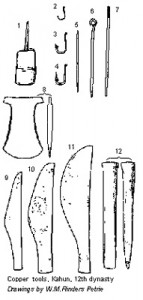Copper may have been the first metal to be worked in Egypt, even before the metallic gold. The ores had a 12% copper content and given the scarcity of fuel and the difficulties of transportation one may well marvel at the fact, that they succeeded at extracting copper at all. In the beginning it was probably worked cold. In early Egyptian graves copper ornaments, vessels and weapons have been found as well as needles, saws, scissors, pincers, axes, adzes [12], harpoon and arrow tips, and knives.
This wide array of tools made of a metal difficult to cast and even with tempering too soft to be of use with any but the softest stone and wood shows the urgent need people felt for tools more flexible than what could be made of wood and stone. Pure copper (like silver or gold) has a hardness factor of 2.5 to 3 on the Moh scale which is just about the same as limestone’s. Naturally occurring copper is somewhat harder due to metallic impurities. Thanks to tempering, copper chisels [7] and saws could be used to work freshly quarried limestone from the 4th dynasty onwards, but annealing with fire and hammering also rendered the tools more brittle. Because of the metal’s softness, copper tools lost their edge quickly and had to be resharpened frequently. When cutting and drilling grit was probably used, which lodged itself in the edges of the soft copper bits and performed the abrasive action.
At first copper and bronze tools were similar to their stone equivalents, but soon the properties of the metal, among them malleability, began to influence their design. Fishing hooks were given barbs [8]. Knives grew longer[9]. Sowing needles [10] were fashioned less than 1½ mm thick.
Copper tools found at Kahun
1 Piercer or bradawl with wooden handle
2, 3, 4 Barbed fishing hooks
5 Needle
6 Pin
7 Netting bobbin
8 Hatchet
9,10,11 Knives
12 Chisel
